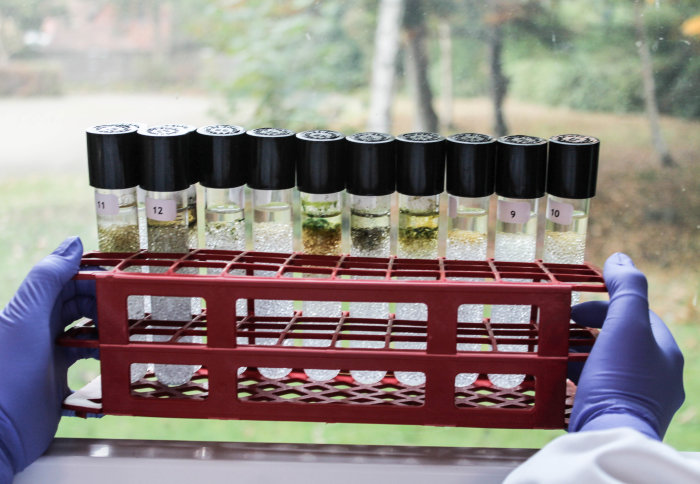Collecting bacterial communities from puddles helps solve ecosystem riddles

Researchers have used puddle ecosystems to start to unravel the roles different bacteria play in complex communities.
Bacteria coat every surface on Earth, living in soil and water, and even inside other creatures including ourselves. They often play critical roles, such as helping us digest food or providing ‘ecosystem services’ like decomposing dead plant matter and returning the nutrients to the soil.
Finding out which kinds of bacteria perform which roles in specific ecosystems could help us engineer optimal communities, for example for use in cleaning up contaminated land or improving the working of our guts.
If we understand how a puddle works, the same general principles should apply to other ecosystems. Dr Thomas Bell
However, bacterial ecosystems are incredibly complex – there are hundreds of different kinds of bacteria in one teaspoon of pond water. This makes it difficult to work out the roles of each type.
Now, a research team led by Imperial College London have untangled some of the roles for bacteria living in puddles – specifically those that form at the base of trees and help decompose fallen leaves.
The study, published today in Nature Microbiology, investigated 753 tree puddles and their bacterial communities, finding patterns that could apply to other ecosystems.
Simplified ecosystems
Lead researcher Dr Thomas Bell, from the Department of Life Sciences at Imperial, said: “Rain puddles are relatively simple, tractable, and easy to find - especially in England - and are as much a part of nature as a lake or stream. If we understand how a puddle works, the same general principles should apply to other ecosystems.”
Previous studies in Dr Bell's lab involved ‘building’ simplified communities, by adding or taking away bacteria one type at a time to try and find their role.

For this study, the team decided to see if conclusions from their lab-created puddles could be extended to real situations. They collected samples from puddles across the south of England, then filtered them in the lab so they only contained bacteria. They then put these communities in controlled environments with their normal ‘food’ – leaves.
Instead of adding and subtracting different kinds, the team relied on the sheer number of communities they had. By looking at how each community functioned, and the abundance of different types of bacteria in each community, they could draw conclusions about who was doing what.
Fecal transplants and habitat restoration
The team were able to associate different types of bacteria with different functions such as respiration or breaking down certain materials. Overall, they found that different parts of the community are important for different ecosystem functions, with rare species responsible for one set of functions and common (abundant) species responsible for a different set of functions.
The team hope method could be used for other types of bacterial ecosystems with wider implications.
Dr Bell said: “The experiment is halfway between the simplicity of the lab and the full complexity of a natural system, so the task now is to extrapolate the results to nature. If it is successful, there are a lot of avenues to pursue that could make use of the method, from faecal transplants to cleaning up pollution using microbes and habitat restoration.”
-
‘Abundance determines the functional role of bacterial phylotypes in complex communities’ by Damian W. Rivett and Thomas Bell is published in Nature Microbiology.
Article text (excluding photos or graphics) © Imperial College London.
Photos and graphics subject to third party copyright used with permission or © Imperial College London.
Reporter
Hayley Dunning
Communications Division